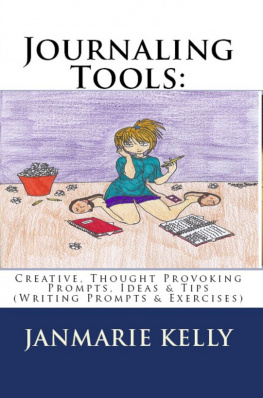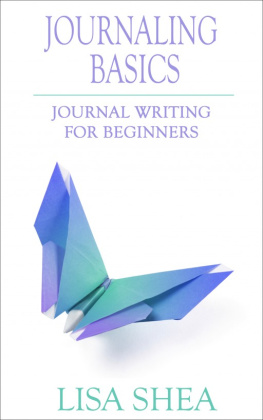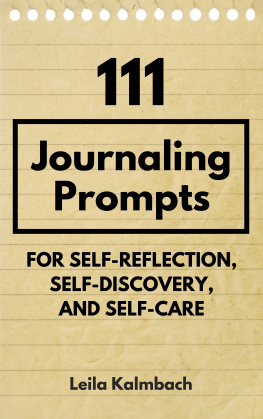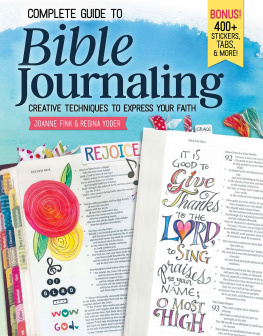CREATIVE
WILDFIRE
AN INTRODUCTION TO ART
JOURNALINGBASICS AND BEYOND
L. K. LUDWIG

BEVERLY MASSACHUSETTS

CONTENTS
CHAPTER 1
Gathering Fuel: How to Get Started

CHAPTER 2
The Tinderbox: Page Surface Techniques

CHAPTER 3
Build a Fire: Using Imagery

CHAPTER 4
Bursting into Flames: Creating Meaningful Content

CHAPTER 5
Feeding the Fire: Adding Details

CHAPTER 6
Keeping the Fire Burning: Fueling Your Creativity

INTRODUCTION
When I found my way, when I discovered that art was my passion, the experience was much like finding my voice. Although this might sound somewhat hokey, its true. I fell head over heels in love with the process of learning and making art.
I first discovered the idea of using books as an art surface in a class I took, in which each student was required to bring artwork to discuss. One of the students, a painter, had found an old hardback book, written in Dutch, in a New York City phone booth. I remember her sitting in the middle of the conference table, showing us this book, whose pages she had filled with marks made with sticks of oil paintlittle explorations of line and shape and color. The pages werent primed, so the paint would eventually eat through the paper, and the thick marks never dried. The book was her fail-safe, and she brought it to class when she had no other work to show. I thought it clever and fascinating. The heady scent of oil paint and the sound of the waxed paper, tucked between the pages so they wouldnt adhere to each other, being pulled away as she turned the pages came together with my childhood love of books and paper, and the experience forever changed how I work. I discovered books as a surface to receive image and color, line and shape.
Being able to speak in the paper pages of books and on canvas with color, image, and words was transformational for melike catching fire. Like a wildfire, but far kinder, each new technique, each new idea, sparked my creativity, causing a surge in my work. Of course, just like real fire, at times my work level burns down, becomes low and smoldering, sometimes only embers, until a new idea or brisk wind comes along and sets my work burning merrily once again.
This book has a dual purpose. One is to provide the basic fodder for starting new fires, information for those who are just beginning the process of keeping an art journal. More than a simple how-to, this book illustrates ways of working with both art mediums and the internal art-making process. The second purpose of this book is to provide sparks for existing fires by offering useful techniques, tips, and insights for those already familiar with art journaling. Throughout this book, Ill provide glimpses into the journals of other artists who share insights into the ways they approach their work.
I asked each of our contributors why art journals appeal to them. Their answers were surprisingly similar: Working in a private journal gives them the freedom to explore new approaches and personal topics. Many of the artists appreciated the ability to record their personal history or tell a storyto become authors and illustrators within their journals.
Join us, and discover how to use art journaling as a way to set fire to your sense of artistic play.

This journal, whose dual covers open like French doors, offers a dynamic art journal form because each time you open the book, a different view is possible.
CHAPTER 1:
GATHERING FUEL: HOW TO GET STARTED
Whats an art journal? An art journal is a space, most often a traditional book, that houses a collection of artwork created on blank pages that are really journal entries. The journal entries, while primarily visual, can explore the full range of an artists experiences: day-to-day life, personal growth issues, life-changing experiences, explorations of new artistic mediums, or simple stories. Pages of an art journal can be covered in paint, collaged with scraps of paper, used to highlight photographs, or showcase drawings. And, while an art journal page may or may not have text to narrate the content, it is the visual elementspaintings, drawings, photographs, and collagesthat combine in an art journal page to communicate clearly what the artist has to say.
The basic fuel for our art journal creative wildfire consists of blank pages and art supplies: scraps and photos, words and thoughts. If you are an experienced art journaler, all you need to do is find a journal with some sturdy blank pages, pull out your art supplies, read through the techniques, decide what to try out first, and ignite!
If you have never done any art journaling, and are not sure how to begin, you may want to read through this book first to get an overview of the process. Your next step will be to choose a journal to work in. There are a plethora of art journal styles, and as you explore the process, you will undoubtedly discover some personal favorites that suit your way of working and the art mediums you choose. In this chapter, youll find information on choosing a journal that is right for you, some commonly used types of art journals for various mediums, and techniques for making a journal of your own from scratch. One piece of advice: Pay attention to the journals shown in this book whose structure or format you are drawn to, and make a list of the type of journal structure they have. Ask yourself, what is it about the style that appeals to you? How does it suit the art mediums you like to use? Is it easily obtained? If you need a portable art journal, will that particular style of journal hold up under wear and tear? Choosing something you like that fits your working style will give you the best start. It is your time to gather information, and gather fuel to feed your own creative wildfire.

Karen Cole created this handmade portfolio folder out of art canvas and treated it as an art journal page by applying collage, writing, drawing, and painting across the entire surface
















